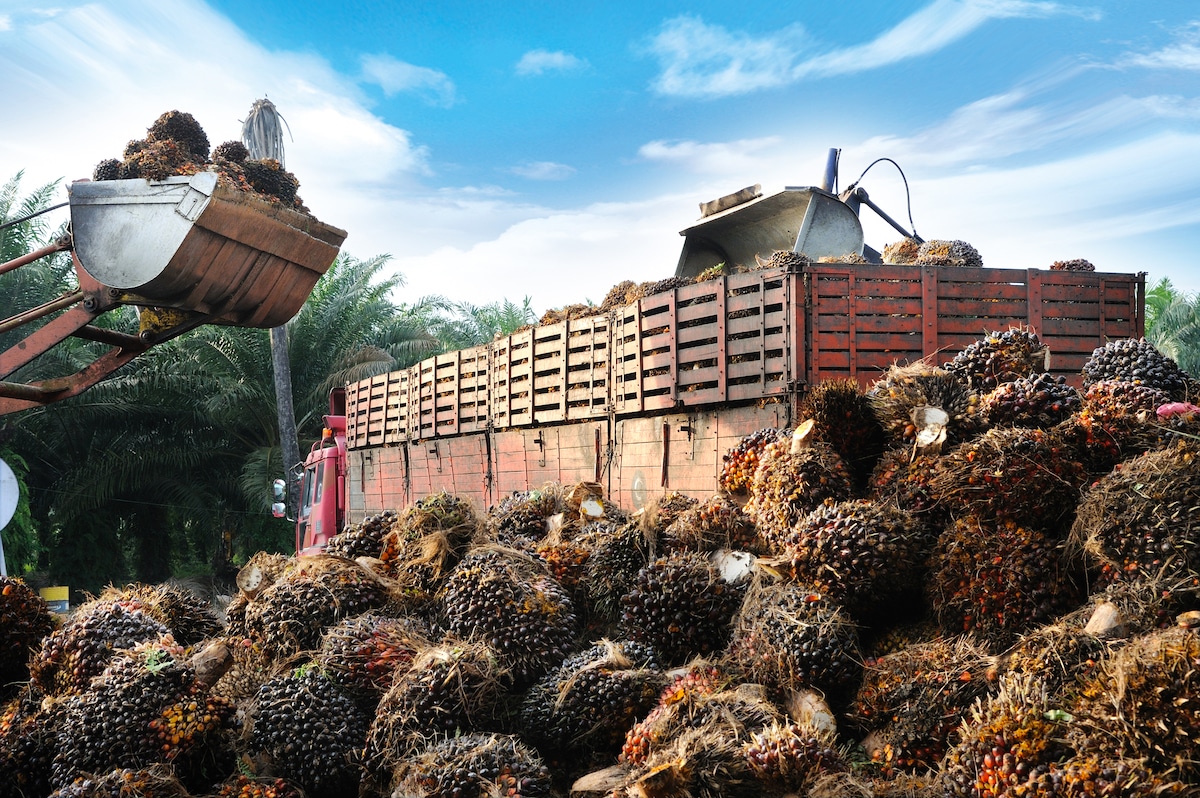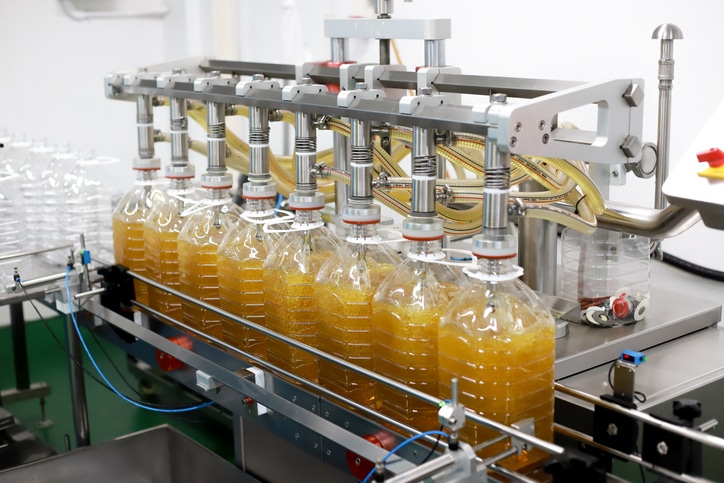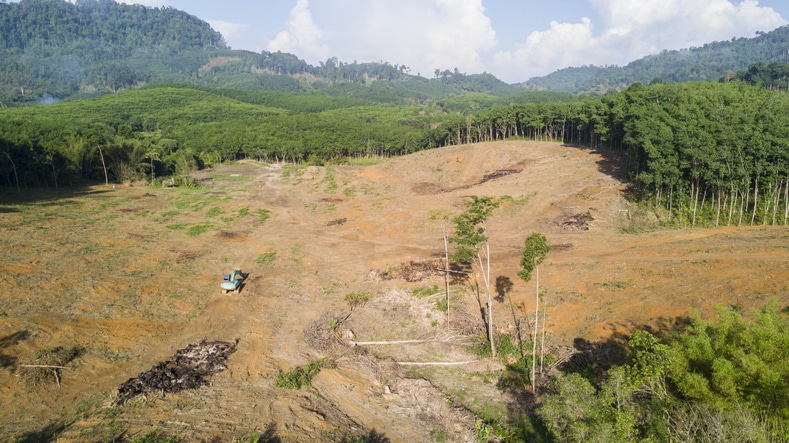Palm Oil 101: Everything You Need to Know

 Why you can trust us
Why you can trust us
Founded in 2005 as an Ohio-based environmental newspaper, EcoWatch is a digital platform dedicated to publishing quality, science-based content on environmental issues, causes, and solutions.
What Is Palm Oil?
If you use cosmetics, take showers or even just eat processed foods, chances are you put quite a bit of palm oil onto or into your body. Made from the fruit of an oil palm plant, palm oil is the most commonly used vegetable oil on the planet, and manufacturers have added it to a ton of different consumer products you’ve probably purchased or seen on shelves.
The popularity of palm oil, a traditional African food staple, has exploded in recent decades as a cooking oil. “Global per capita consumption has more than doubled since 2000 to 7.7 kilograms (17 pounds) in 2015,” noted a Bloomberg article written in 2017, citing Gro Intelligence data.
Palm oil producers can make two kinds of palm oil with the tree’s fruit. One type is crude palm oil, which is made from the flesh of the fruit. Another type is palm kernel oil, which is derived from the seeds of a palm oil plant.

Abdul Aziz Bin Mohamed / EyeEm / Getty Images
While the two types of oil are made from parts of the same plant, they are used for different things. Palm kernel oil is typically blended into products that aren’t intended for consumption, whereas crude palm oil is added to foods, drinks and other edible things, according to a website operated by the Malaysian Palm Oil Council.
There are also some dietary differences between palm kernel oil and crude palm oil. For example, “while over 80% of the fat in palm kernel oil is saturated, only 50% of palm oil is, making it easier on arteries,” noted Eating Well.
But rainforest advocates worry about the deforestation, biodiversity loss and other environmental pollution concerns that accompany palm oil, as well as numerous human rights problems.

richcarey / iStock/ Getty Images Plus
What Products Use Palm Oil?
According to the Orangutan Alliance, palm oil accounts for roughly a third of all vegetable oils used around the planet. If that makes it sound like it must be in a lot of stuff, that’s because it is. Palm oil has been added to just about everything you might find at a beauty supply shop or grocery store that has been processed in some way.
“Three-quarters of total palm oil produced is used for food, particularly cooking oil and processed oils and fats,” notes the Orangutan Alliance on its website. “It is also used in cosmetics, cleaning products and biofuel.”
Here is a list of some of the many common household products that use palm oil in their products:
- Foods that benefit from having a creamy or smooth texture or taste, like cookies, chocolate and ice creams
- Foods that need some kind of stabilizing ingredient, like peanut butter and hazelnut spreads
- Ingredients that might stick together without it, like pizza dough
- Certain pre-cooked foods, like instant noodles
- Certain foods that required a different fat after the U.S. banned artificial trans fats in 2018, like margarine
- Cosmetics and personal care products, such as shampoos, conditioners, soap or lipstick
- Household cleaners, like laundry detergents
- Biofuel and biodiesel
Palm oil is also used to some extent in pharmaceuticals, according to a recent report from Grand View Research.
Numerous organizations, like Ethical Shopper, have compiled lists of companies that irresponsibly and responsibly use palm oil (more on sustainable palm oil later). Here’s a list of some of the corporations that are known to use palm oil, according to Ethical Shopper and Triple Pundit:
- Domino’s Pizza
- Burger King
- Yum! Brands (which owns fast food spots like KFC)
- Subway
- Pret A Manger
- Nestlé
- Unilever
- Kellogg’s
- Starbucks
- L’Oreal
- Mars, Inc.
- Hershey’s
- Mondelēz
- Procter & Gamble
- Reckitt Benckiser
What Are the Manufacturing Benefits of Palm Oil in Products?
The Malaysian Palm Oil Council says that palm oil is a stable, edible oil that “can be easily blended with other types of fats and oils for food formulations.” It also helps with foaming in firefighting products and cleaning supplies.
Is Palm Oil Good for Your Health?
Some studies have shown some positive health benefits, according to Healthline.
“Palm oil may help protect brain function, reduce heart disease risk factors and increase vitamin A levels in certain people,” the health news site reported in February 2022.
And ever since the U.S. banned artificial trans fats in 2018, palm oil has frequently been used as a substitute for the substance, which raises bad cholesterol and lowers good cholesterol, according to the Mayo Clinic. Nonetheless, if you’re looking at an otherwise unhealthy food (looking at you, fried foods), adding palm oil isn’t going to suddenly cancel out the other negative health aspects.
Where Does Palm Oil Come From?
Even though the oil palm tree is a plant native to Africa, the World Wildlife Fund says that most palm oil — roughly 90% — comes from oil palm trees on a handful of Malaysian and Indonesian islands. But oil palm trees grow in tropical rainforests throughout Asia and Latin America, as well as west and central Africa, according to the conservation nonprofit.
How is Palm Oil Made?
Oil palm trees will constantly produce fruit after reaching maturity, typically two or three years after being planted, according to an initiative co-funded by the European Union.
“The first step in the palm oil production process is harvesting the palm fruit,” explains the initiative, called foodunfolded. “Harvested bunches are transported to factories where they are first sterilized and then threshed.”
At that point, workers use a mechanical press to expel oil from the oil palm fruit’s pulp. Oil palm fruit kernels are removed and pressed separately from the rest of the plant, according to the initiative. The palm oil is then refined, the exact process dependent on what the palm oil will be used to help manufacture.
What Are the Environmental and Social Impacts of Palm Oil?
Despite the many commercial applications for palm oil, the substance isn’t a universally beneficial miracle product. That’s because, for all the benefits that can be derived from it, palm oil production carries many environmental and social problems that have proven difficult to overcome even for companies engaged in a resolution.
Palm oil production has led to drained peatlands and illegal deforestation throughout Southeast Asia, Latin America and Africa. In Indonesia, for example, millions of acres of rainforest are demolished every year for timber, palm oil production and other commercial needs.
Even though Mongabay, a conservation news network, reports that palm oil-related deforestation in Indonesia saw significant declines in 2020, other economic and meteorological factors were behind the slowdown.
The deforestation of tropical rainforests in pursuit of palm oil production threatens many species, some of which have even become extinct in recent years.
According to The Orangutan Project, “during the past decade the orangutan population has decreased by approximately 50% in the wild.”
“This is primarily due to human activities including rainforest destruction for palm oil plantations,” the group said. “At present, 80% of orangutan habitat has been altered or lost.”
Numerous species of elephant are also endangered because of palm oil production, says the World Wildlife Fund. Sumatran and Borneo elephants, both endangered species, are constantly losing habitat to palm oil production.
Rainforest Rescue and the International Elephant Foundation both report that Borneo pygmy elephants are even being poisoned for being “pests on the oil palm plantations.”
And in late 2019, the Sumatran rhino became extirpated (meaning locally extinct) in Malaysia. Although that specific rhino died of cancer, its numbers had dramatically dwindled in Indonesia and Malaysia in part because of the demand for palm oil and the growth of palm oil plantations, according to the Independent.
Newly published estimates show there are likely fewer than 50 Sumatran rhinos left in the wild, according to Mongabay.
All that deforestation is also associated with air pollution concerns, since many palm oil producers will burn huge swaths of rainforest in uncontrolled fires to clear the way for oil palm plantations.
Another problem with palm oil production is soil and water pollution.
“A palm oil mill generates 2.5 metric tons of effluent for every metric ton of palm oil it produces,” says the World Wildlife Fund. “Direct release of this effluent can cause freshwater pollution, which affects downstream biodiversity and people. While oil palm plantations are not large users of pesticides and fertilizers overall, the indiscriminate application of these materials can pollute surface and groundwater sources.”
That can be seen through the example of some palm oil producers directly dumping palm oil residues — composed of herbicides, insecticides and other materials — into waterways, destroying the rivers and soils the substances pass through.
And all that rainforest deforestation also comes with a climatological cost, as the longstanding rainforests and peatlands that are destroyed to host oil palm plantations anchor significant amounts of carbon until they are burned to the ground. At that point, all that carbon is released, contributing to global warming.
Palm oil production has also been linked to human and labor rights abuses, such as enslavement and child labor.
All the water and soil pollution harms the quality of life of the humans who live in that environment, causing them to rely on deliveries of bottled water instead of the waterways they live beside. It also reduces their ability to work their native land, as arable soils or fishable waterways are polluted or destroyed.
What Is Sustainable Palm Oil?
A number of nonprofits, governments and corporations want to continue to use palm oil but do so in a way that doesn’t destroy human and natural environments across the planet. Introducing sustainable palm oil, which is just what it sounds like: palm oil from producers that either claim to be or have met third-party criteria to be more sustainable for the environment than not.
Numerous organizations have established annual reports and scorecards evaluating the progress or stagnation of different palm oil producers — or the corporations that purchase the substance from them — toward their stated sustainable palm oil goals. Some of those organizations include the Union for Concerned Scientists.
Then there’s the Roundtable on Sustainable Palm Oil, a global initiative that sets criteria that entities within the palm oil production process can strive to meet to be considered a sustainable palm oil producer. If an entity meets the threshold, the retailer selling a product using that entity’s palm oil can use a specific emblem on its packaging to signal its compliance.
“In 2017, about 19-20% of all global palm oil production was certified by the Roundtable on Sustainable Palm Oil,” according to a 2018 report by the International Union for Conservation of Nature. “The inception of the roundtable in 2004 was the starting point for companies in the palm oil sector to embrace the concept of sustainability in a voluntary way.”
“Since then, the standard has seen slow but consistent progress in terms of uptake,” the IUCN added. Growers certified by the RSPO amounted to almost one-fifth of total worldwide palm oil producers in 2014, according to the organization.
The World Wildlife Fund also issues a report card for major international palm oil buyers. In its 2021 report card, the organization found that out of 227 palm oil buyers assessed, “not one single one [achieved] full marks.”
“While some companies have made commendable efforts to eliminate deforestation, conversion and human rights abuse from their palm oil supply chains, palm oil buyers as a whole can and should do much more to deliver positive impact at scale and at pace,” the nonprofit said, later noting that “the 2021 scorecard is a reminder of the tremendous progress that has yet to be made.”
How Do I Know if Palm Oil Is in a Product?
Certain certifications like RSPOs will make it clear that a product uses palm oil by claiming that that item has used a sustainably sourced version of the substance. But other times it’s less clear because companies will cite their use of palm oil in unclear ways to the average consumer.
According to the World Wildlife Fund, companies may use the following terms to indicate there is palm oil in their product:
- Vegetable Oil
- Vegetable Fat
- Palm Kernel
- Palm Kernel Oil
- Palm Fruit Oil
- Palmate
- Palmitate
- Palmolein
- Glyceryl
- Stearate
- Stearic Acid
- Elaeis Guineensis
- Palmitic Acid
- Palm Stearine
- Palmitoyl Oxostearamide
- Palmitoyl Tetrapeptide-3
- Sodium Laureth Sulfate
- Sodium Lauryl Sulfate
- Sodium Kernelate
- Sodium Palm Kernelate
- Sodium Lauroyl Lactylate/Sulphate
- Hydrated/Hydrogenated Palm Glycerides
- Ethyl Palmitate
- Octyl Palmitate
- Palmityl Alcohol
Should You Boycott Palm Oil?
Some organizations, like Rainforest Rescue, do suggest avoiding palm oil.
“Remember that the customer is king: Ask your retailers for palm oil-free products, write product manufacturers and ask them why they aren’t using domestic oils,” notes the organization on its website. “Companies can be quite sensitive to issues that give their products a bad name, so inquiring with sales staff and contacting manufacturers can make a real difference. Public pressure and increased awareness of the problem have already prompted some producers to stop using palm oil.”

But while the gut reaction to the environmental degradation around palm oil may be to avoid it as much as possible, other industry observers and environmental advocates say that positive intention is misplaced and could instead lead to negative repercussions for the impacted ecosystems.
“Avoiding palm oil could have worse effects because it might take support away from companies that are trying hard to improve the situation,” explains the World Wildlife Fund. “This could encourage companies to use other products that may have even more impact on the environment.”
Additionally, while you could theoretically reduce your household consumption of palm oil by purchasing products that don’t have any oils and avoiding processed foods, there are actually some environmental benefits to using palm oil instead of other types of vegetable oils.
That’s because while oil palm plants produce quite a bit of oil per plant, other types of vegetable oil-deriving plants are less efficient and would need more land to yield the same amount of vegetable oil — a lot more land.
“Palm oil is currently produced from just 10% of all farmland dedicated to growing oil crops, yet accounts for 35% of the global volume of all vegetable oils,” according to a 2018 article written by Mongabay.
According to the World Wildlife Fund, “to get “the same amount of alternative oils like soybean, coconut or sunflower oils, you would need anything between four to 10 times more land, which would just shift the problem to other parts of the world and threaten other habitats, species and communities.”
That and, given that palm oil is in so many common household products, it may be impossible to avoid as a typical consumer. Instead of boycotting, voting with your dollars — that is, choosing products that come from companies that share a desire to sustainably source palm oil — is a more realistic option for some shoppers.
Subscribe to get exclusive updates in our daily newsletter!
By signing up, you agree to the Terms of Use and Privacy Policy & to receive electronic communications from EcoWatch Media Group, which may include marketing promotions, advertisements and sponsored content.

 233k
233k  41k
41k  Subscribe
Subscribe 




